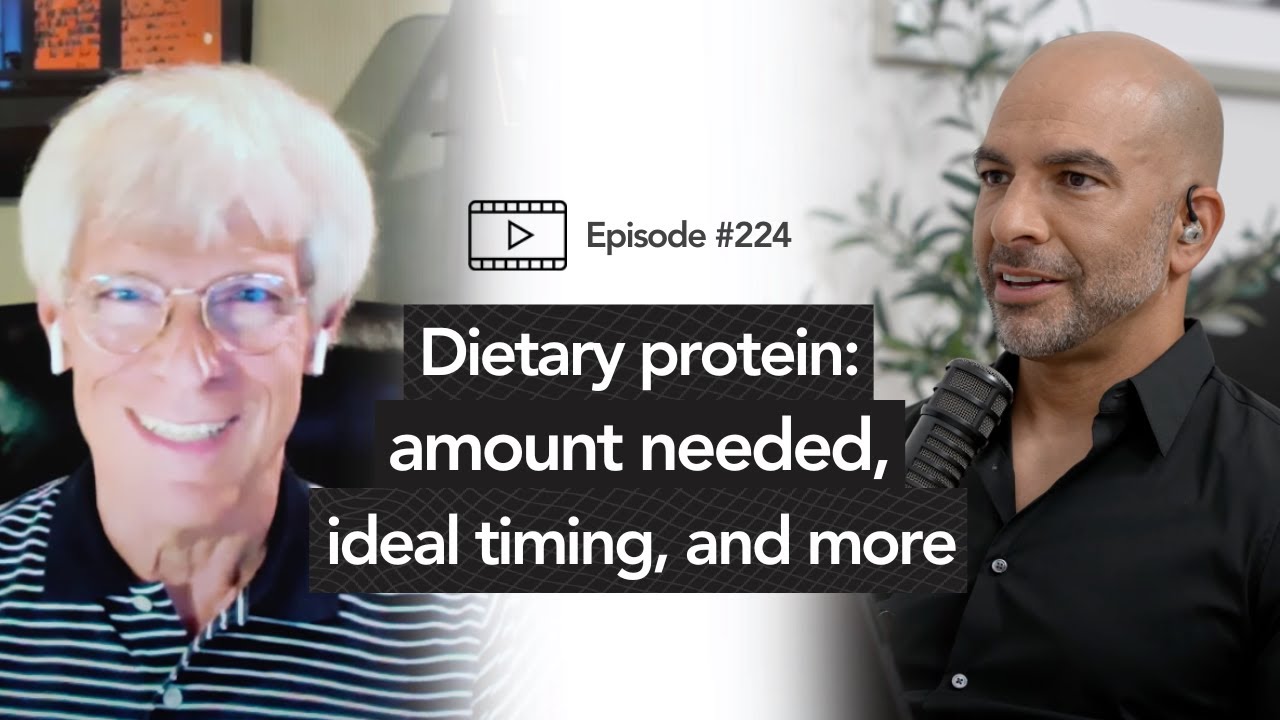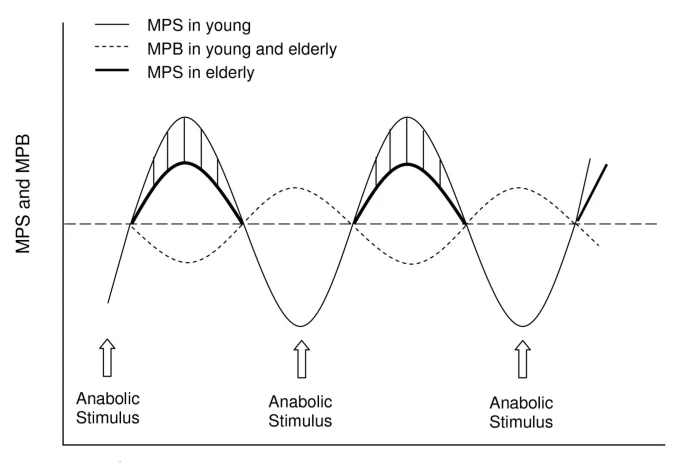- What the Recommended Dietary Allowance (RDA) for protein is
- How you can determine the quality of a protein source
- How you can effectively track your daily protein intake
- The relationship between aging and your dietary protein needs
- Optimal protein distribution and timing
- How time-restricted eating affects muscle protein synthesis
- The outcomes of pre and post-workout protein consumption
- The effects of a high-protein diet on fat loss
Dietary Protein: Amount Needed, Ideal Timing, Quality, and More
Dietary Protein: Amount Needed, Ideal Timing, Quality, and More

- Assess the quality of a protein source based on whether it delivers a sufficient amount of these three essential amino acids, namely leucine, lysine, and methionine. The quality of a protein source also depends on its bioavailability. Animal proteins tend to have a bioavailability of 100%, while plant proteins are typically only 60-70% bioavailable in their raw form.
- As you get older, you can maintain healthy muscles by increasing your protein intake and improving the quality of the proteins you consume.
- Avoid distributing your protein intake into many small meals throughout the day. A minimum of 30 grams of protein is required to bring your muscles out of their catabolic state.
- It's best to consume 45 grams of protein and up during breakfast and dinner.
- The fraction of protein in your meal should increase as you cut back on your total calorie intake if you want to lose weight and maintain muscle mass.
What’s the Recommended Dietary Allowance (RDA) for Protein?
Currently, the Recommended Dietary Allowance (RDA) for protein is 0.8 grams of protein per kilogram of body weight. This recommendation, however, is the amount of protein thought to meet the basic nutritional needs of the general population. Various factors, such as your age and the quality of proteins consumed, can alter how much protein you need each day to optimize your wellness.
Determining the Quality of a Protein Source and Tracking Your Protein Intake
The quality of a protein source is determined by the balance of amino acids present as well as its bioavailability. In general, a high-quality protein source should have a high bioavailability percentage and deliver all the essential amino acids your body needs.
How Amino Acids Affect the Quality of a Protein Source
Amino acids are the building blocks of protein and play a significant role in tissue repair and growth. Non-essential amino acids can be synthesized by the body, while essential amino acids cannot be produced by the body. Thus, these nine essential amino acids must be obtained from your diet.
“We don’t really have a protein requirement; we have a requirement for nine essential amino acids.”
Don Layman, Ph.D.
Different sources of proteins offer a different balance of amino acids. For example, grains tend to be limiting in the amino acid lysine, while lentils and legumes are typically limiting in methionine. Meanwhile, animal proteins like meat, poultry, and fish are a complete source of these essential amino acids.
| Essential | Nonessential |
| Histidine1 | Alanine |
| Isoleucine | Arginine |
| Leucine | Asparagine |
| Lysine | Aspartic acid |
| Methionine | Cysteine |
| Phenylalanine | Glutamic acid |
| Threonine | Glutamine |
| Tryptophan | Glycine |
| Valine | Proline |
Table 1: Essential and Nonessential Amino Acids
How to Track Your Protein Intake
An effective method of tracking your protein intake would be to keep tabs on the quantity of essential amino acids you consume daily. To simplify this tracking process, you should focus primarily on three amino acids, namely leucine, lysine, and methionine. Obtaining sufficient amounts of each in your daily meals will help you meet your daily protein intake requirements in a holistic manner.
How the Bioavailability of a Protein Source Affects Optimal Protein Intake
Another factor that determines the quality of a protein source is its bioavailability and how much of it can be digested and absorbed by the human body. Animal proteins and most isolated proteins have a digestion-absorption rate that’s incredibly close to 100%. In contrast, plant proteins are attached to fibers, and in their raw form, they’re just 60-70% bioavailable.
Because of this, an individual who chooses to go on a plant-based or vegetarian diet would need to consume a greater amount of proteins each day to ensure they receive a sufficient amount of all essential amino acids.
The Association Between Age and Your Dietary Protein Needs
As you get older, the aging process decreases protein turnover efficiency and blunts your response to protein feeding. Aging also ushers in a drop in the hormones that regulate protein synthesis. As such, you’ll have to make up for the decrease in protein turnover efficiency by consuming a greater quantity of high-quality proteins that contain the essential amino acids your body needs.

Source: https://nutritionandmetabolism.biomedcentral.com/articles/10.1186/1743-7075-8-68
“As we get older, we can buffer that loss of the hormones via higher-quality protein, mostly leucine, and resistance exercise.”
Don Layman, Ph.D.
Optimal Protein Distribution, Timing, and Time-Restricted Eating
You can leverage these main principles when determining your protein distribution throughout the day:
- Your muscle stays catabolic (in the state of breaking down tissue) until you have a meal that consists of 30 or more grams of protein. Thus, distributing your protein intake into many small meals throughout the day will not effectively stimulate muscle protein synthesis.
- The human body typically achieves peak anabolic response when around 25-60 grams of protein are consumed in a meal. Therefore, consuming too much protein in one sitting will not be as beneficial as distributing your intake into two or more meals. This is also why time-restricted eating that only allows one meal throughout the day will be less advantageous.
- The first and last meals of the day carry the greatest importance. It’s best to consume 45 grams of protein and up during at least two meals, which are preferably breakfast and dinner. This amount of protein hits the sweet spot, where you’re consuming enough to stimulate a response without having too much that its beneficial effects plateau.
Protein Intake Timing and Training
Consuming proteins right before a workout wouldn’t make a significant difference because exhaustive exercise is catabolic by nature.
However, your protein intake timing after working out may matter, but mainly for individuals who have recently begun training. In this case, the biggest effects of protein feeding are seen in a two-hour window after exercise. However, the more you’ve trained, the smaller this effect will be. Thus, individuals who have undergone training for a couple of months will see little difference between consuming protein within that two-hour window and spreading it out across the day.

Source: https://www.researchgate.net/figure/Effect-of-protein-ingestion-after-acute-resistance-exercise-on-muscle-protein-synthesis_fig3_317051068
“Once you get to a point where you’re well trained enough, you don’t have to be so maniacal about meal timing. You can just focus on the big picture, which is total protein, protein quality, and spreading it out such that you don’t exceed the metabolizable fraction of it at any one sitting.”
Peter Attia, MD
High-Protein Diets and Fat Loss
Research has shown that people on a higher-protein diet lost a greater quantity of total weight and fat and better maintained their lean muscle mass than those on a lower-protein diet despite consuming the same amount of calories. The higher-protein diet also helped to maintain satiety more effectively.
“We want weight loss, but we don’t want people to lose any lean mass, especially if they’re adults”
Don Layman, Ph.D.
As you reduce your calorie intake to lose weight, you should not be cutting back on your protein. Quite the opposite, the fraction of protein in your diet should increase as you cut back on your calorie intake. Not only will this better maintain satiety, but it can also help preserve lean tissue mass. Plus, the thermogenic effect of protein may help steer the weight lost toward fat instead of muscle.



